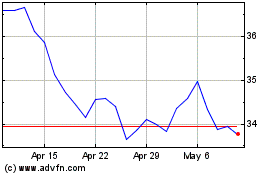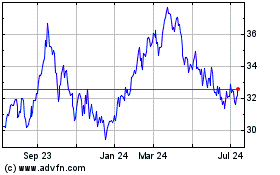By Adrienne Roberts and John D. Stoll
U.S. light-vehicle sales hit a second consecutive annual high,
aided by a fourth-quarter surge in demand that exceeded
expectations and bolstered the outlook for an industry that has
been a key engine for economic growth.
Such gains, however, are coming with a steep price tag.
December's sales pace, one of the strongest monthly performances in
the industry's history, was fueled by discounts of $3,542 per
vehicle on average, according to J.D. Power, an independent
research firm.
That represents a 10% discount off the original asking price and
is an incentive level not seen since the beginning of the financial
crisis.
Auto makers are dishing out incentives to spark demand for
passenger cars, including sedans, which aren't popular when
gasoline prices are low. Such giveaways also are necessary to keep
drawing buyers to dealerships after seven consecutive years of
growth. Even with brisk sales, Detroit's three auto makers are
closing some factories in January to lower inventories or even
laying workers off at car plants.
Still, President-elect Donald Trump's administration will
inherit a far healthier auto industry compared with what President
Barack Obama encountered eight years ago. In 2009, auto sales were
collapsing amid a wider financial crisis and the Obama
administration spent considerable time crafting bailouts for
Detroit car companies and figuring out how to goose sales.
Judy Wheeler, Nissan Motor Co.'s head of U.S. sales, said in an
interview that with "consumers settling down after the election"
and reasonably low gas prices, she sees the industry maintaining
its stability into 2017.
Bill Fay, an executive with Toyota Motor Corp., said he thinks
the incentive spending that carried 2016 to a record will moderate
and 2017 will get off to a strong start.
But some dealers are unsure if the momentum will last.
Phil Maguire, owner of Maguire Family Dealerships based in
Ithaca, N.Y., is expecting a strong year ahead and investing in
internal operations. He acknowledges low gasoline prices and strong
demand for light trucks are supporting sales. "It will be
interesting to see how long the market can hold out."
Auto makers sold 1.69 million vehicles in December, 3.1% more
than the same period in 2015 despite one fewer sales day. The
seasonally adjusted selling pace of 18.43 million was the highest
since July 2005, when General Motors Co. and other auto makers
stoked demand with a new campaign that offered employee pricing to
all customers. A total of 17.55 million vehicles were sold in 2016,
roughly 60% of which were classified as light trucks.
That compares with 17.48 sales million a year earlier and a mix
of 56% light trucks. Growth in demand for pricier pickups,
sport-utility vehicles and crossover wagons has helped pad auto
maker profits as executives invest to speed development of
autonomous cars and spend heavily to meet stricter emissions
standards.
Shares of GM shot up 5.5% to close at $37.09 as of 4 p.m.
trading on Wednesday, just shy of a 52-week high set last month.
Ford Motor Co. closed up 4.6% at $13.17.
Audi AG's U.S. chief, Scott Keough, said it is unclear what role
the election or response to Mr. Trump's policies had in December's
boost, but noted there was a change in momentum for the
industry.
"We had the most amount of traffic at our stores that we've ever
seen," he said, acknowledging the role incentives played for the
German luxury brand and the wider market. "December was an
incredible month."
"The country was tangled up in knots for six to seven months not
knowing what was going to happen," Mr. Keough said. The certainty
after the election, he said, is "a good thing."
Mr. Keough said December is historically a strong month and
noted there are still pockets of weakness in the overall market,
including certain luxury players.
"We are nearing a peak," Mr. Keough said regarding the luxury
market. "We need to manage and behave accordingly."
Dealers are planning for continued good times, with many
committing to store upgrades or other facility improvements. Joe
Eberhardt, Jaguar Land Rover's North America chief, said Wednesday
that 250 of the company's North American dealers have committed to
spend a total of $1.5 billion on improvements, including moving to
new design elements in showrooms.
"The investments will take time," Mr. Eberhardt said, adding
that retailers will spend that money over the next half-decade or
so. "A big part of the story line over the next couple years is
that sales will remain strong," he said.
Among individual players, GM logged a 10% increase compared with
December 2015, selling 319,108 vehicles, while Ford sales edged up
0.1% to 237,785 as F-series pickups posted their best month in 11
years.
Fiat Chrysler Automobiles NV, meanwhile, reported sales slipped
10% to 192,519 vehicles, as it cut back on daily rental sales and
continued to rely on Jeep and Ram pickups for an increasing amount
of its volume.
Toyota sales rose 2.1%, Nissan sales climbed 9.7% and Honda
Motor Co. booked a 6.4% increase to 160,477 vehicles, as a 4% slip
in cars sales was lifted by an 18% jump in truck sales.
--Anne Steele contributed to this article.
Write to John D. Stoll at john.stoll@wsj.com
(END) Dow Jones Newswires
January 05, 2017 02:48 ET (07:48 GMT)
Copyright (c) 2017 Dow Jones & Company, Inc.
Honda Motor (NYSE:HMC)
Historical Stock Chart
From Mar 2024 to Apr 2024

Honda Motor (NYSE:HMC)
Historical Stock Chart
From Apr 2023 to Apr 2024
